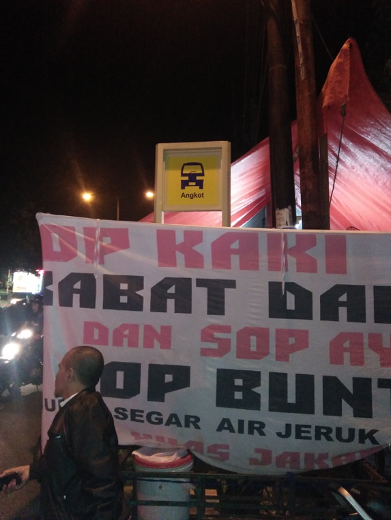ANGKOT Stop Signage
By Intan Suci Lestari
Design is a solution created to meet human needs. Solutions that make the quality of human life better, facilitate community activities in daily life. Effective design products are appropriate and right on target. Appropriate in meeting individual needs, social life among fellow humans, and the needs of their interaction with the environment.
Design – especially visual communication design – has become one of the building blocks of visual culture in society that touches almost all visual aspects seen daily (Sachari, 2007). One of the products of visual culture that is often encountered every day is signage. According to Tinarbuko, Signage is a series of visual representations and graphic symbols that aim as a medium for human interaction and communication with the public space (Tinarbuko, 2008). In general, the information contained in signage is in the form of messages to find directions, the identity of places and locations, instructions for using something, lighting pathways, and so on.
In an urban environment, the existence of signage is very much needed in helping people run smoothly with their various activities. Signage can be found in every corner of the city whose visual appearance fills the streets, parks, buildings, and other facilities such as schools, offices, shopping centers, hospitals, and others. With signage, the process, access, and social interactions of the community will be more organized. The environment will look more comfortable and orderly, not only to create order but also as a tool for the beauty of the city. Signage is said to be effective if the message can be understood by most of its users, or in other words, it succeeds in influencing human behaviour to the message it displays (Mulyana, 2006). To achieve its objectives, signage must consider technical factors such as language and visual elements. In addition, good signage must also show non-technical factors such as human perception of signs, mentality in individuals, or certain habits in society. Humans as the target of visual signage communication media have various factors that influence them when dealing with signage. these factors then become the basis for a person to behave.


Figure 1 ANGKOT Stop Sign in Bandung (Private Documentation)
On the one hand, the existence of signage is to help and make it easier for humans to do activities in their environment, but on the other hand, there are also portraits of human behaviour that don’t pay attention to signs. One example of signage that is of concern in this article is the public transportation signage that is installed at many points of the ANGKOT routes (public transportation) in the city of Bandung. ANGKOT is the most common public transportation found on the streets of Bandung with a variety of routes that cover all areas. With so many existing ANGKOT routes, it is very difficult to find sources of information that provide ANGKOT routes. previous Head of the Transportation and Terminal Division of the Dinas Perhubungan Kota Bandung Yoseph Heryansyah, stated that to create traffic order, especially for public transportation (ANGKOT), Dinas Perhubungan has installed a statue called signage, which functions for passengers to wait at the point where signage is installed. (Tribun Jabar, 2016).
The ANGKOT stop signage in Bandung is the first signage board regarding the first public transportation route made in Indonesia. This phenomenon raises questions in my mind as an author to be investigated more deeply. Does the making of this signage make the behaviour of public transportation drivers stop and pick up passengers at the signage point or even ignore the signage? Do public transportation passengers find it easy to travel using ANGKOT with the help of provided information on the signage? And to what extent is the effectiveness of this signage board for the people of Bandung?
Based on these thoughts, the author wants to know the significant factors that become the background of the behaviour of public transport users on the signage that has been made by Dinas Perhubungan Kota Bandung. If the implementation of public transportation signage is still ineffective, what are the factors behind the behaviour that does not ignore signage, both signage as a stimulus factor or other factors? Is this solely due to the low literacy of reading Indonesian society in general? This is interesting and we should reflect together on the advancement of Indonesia’s human resources in the future.
Tinarbuko, S. (2008). Semiotika Komunikasi Visual. Yogyakarta: Jalasutra.
Mulyana, D. (2006). Ilmu Komunikasi: Suatu Pengantar. PT. Remaja Eosdakarya:
Bandung
https://jabar.tribunnews.com/2016/11/12/dishub-pasang-signage-agar-naik-dan-turun-penumpang-angkutan-lebih-tertib


Comments :